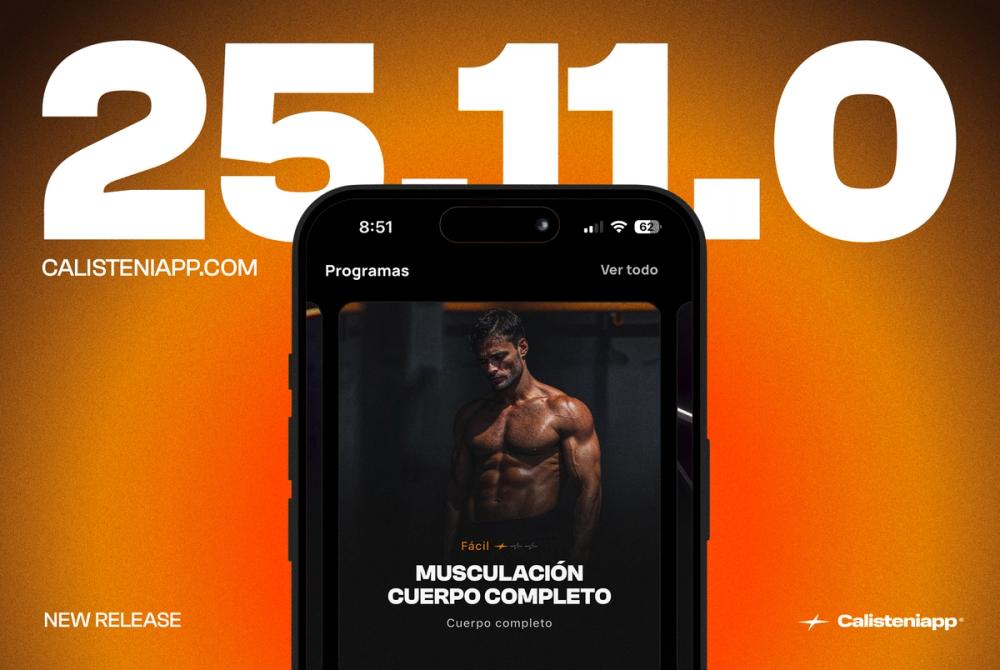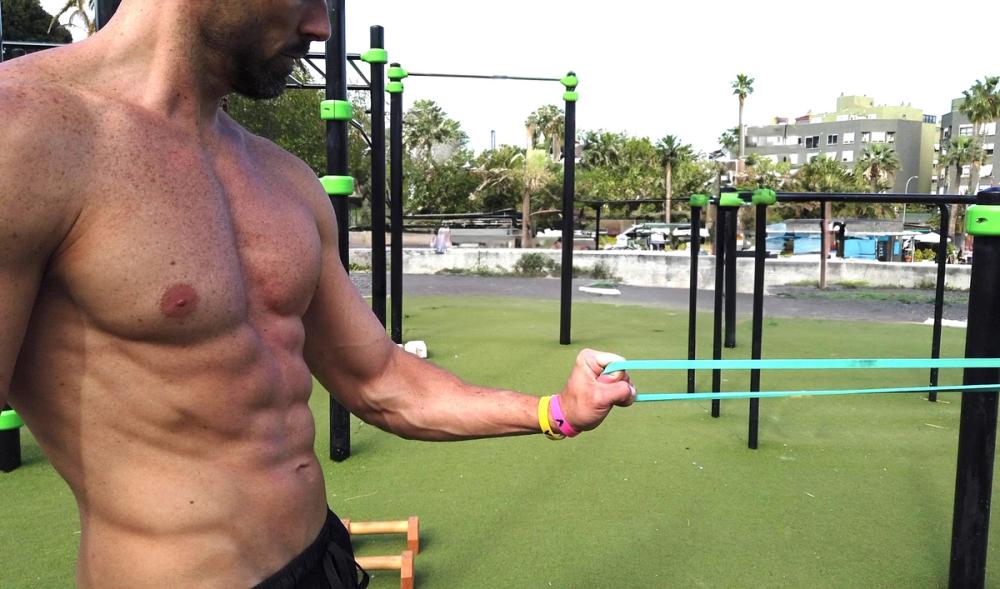
Release 25.11.0 - A new beginning
Calisteniapp is a symbol that represents our obsession with excellence, our essence, and the path we want to define for the next ten years.

After more than 10 years training calisthenics at the park, this past year I’ve been combining it with gym sessions to train weighted calisthenics, also known as Streetlifting.
In my case, it hasn’t just been about occasionally going to the gym to add some weight; I’ve made it a priority. I created a training periodization plan and steadily improved my numbers, training with weights at least three times a week.
This has allowed me to truly experience what it’s like to train with added weight and to appreciate the differences, advantages, and disadvantages compared to traditional calisthenics. In this article, I’d like to share my insights, hoping it might help you in your own training journey.
Let’s explore whether weighted calisthenics offers something significantly valuable, whether traditional calisthenics has unique qualities that make it special, which approach yields better results, and much more.

Let’s start with the most obvious differences—the ones you notice right away but are crucial to highlight because they can be decisive depending on the individual and situation.
The first is that to train weighted calisthenics, it’s most common to go to a gym.
While some people bring weights to the park using vests, stones, or other rudimentary methods, it’s neither the most comfortable nor practical option. For instance, if you need to perform dips with 70 kilograms, it’s challenging to achieve that weight with vests and stones alone.
Some people have home setups with bars, but this is far from typical.
This means that training weighted calisthenics often requires a gym membership, whereas traditional calisthenics does not. That’s an important factor to consider.
Additionally, even if you’re paying for a gym membership, you’ll likely need to invest in your own equipment. For weighted calisthenics, a dipping belt is essential, and gyms usually don’t provide one.

From my experience, I’ve been to gyms with a dipping belt available, but there’s usually only one. Sometimes someone else is using it, or I’d feel awkward monopolizing it for two hours, leaving others waiting. It was much more practical to buy my own. Luckily, a standard dipping belt isn’t very expensive—mine cost about €20.
If you progress to a high level in weighted calisthenics or decide to compete, you’ll probably need additional gear like elbow sleeves, knee sleeves, and a squat belt. This equipment can cost over €200, but this is typically only necessary for competitive athletes or those lifting significant weights.
Another downside of gyms is overcrowding. You might have to wait to use the pull-up bar, dip station, or squat rack. And if you’re incorporating machines into your routine, the situation can get even worse.
Interestingly, even in a crowded calisthenics park, this dynamic is different. People use the bars for their set and then free them up for the next person. In the park, there isn’t this unwritten gym rule that if someone is using equipment, it’s “theirs” until they’re done, and you need to wait or ask for turns. This is partly because there’s no need to load and unload weights in the park, but overall, it’s another point in favor of traditional calisthenics.

An aspect that may seem minor but is important to calisthenics practitioners is the restriction on going barefoot or using chalk in gyms.
Being barefoot is often important for exercises like handstands, planches, or front levers. As for chalk, it’s crucial for most training sessions, especially when attempting muscle-ups or weighted pull-ups. Without chalk, it’s nearly impossible to train effectively or push close to your limits.
In my experience, I’ve felt like a criminal sneaking chalk into the gym, constantly checking that no staff were watching. I eventually switched to liquid chalk, which drew less attention, and made sure to clean up every trace of it afterward.

Another minor but noticeable issue is the music. In gyms, you can’t choose the playlist, and it’s often repetitive or uninspiring. There’s also the matter of not being able to train shirtless, a common comfort for calisthenics athletes.
In contrast, at the park, there are moments where it feels like a celebration of training—good music chosen collectively, everyone barefoot and shirtless, and a relaxed yet focused atmosphere.
Space is another concern. When I wanted to practice planches or handstands in the gym, finding enough room was sometimes impossible. Crowded gyms can make it hard to claim even two square meters for yourself. This is rarely an issue in the park, where you can move to the side and find all the space you need.
From a social perspective, traditional calisthenics also wins. Parks are more conducive to forming workout groups, motivating each other, and socializing. Gyms often have a more individualistic atmosphere, with little interaction among people.
Weighted calisthenics has the advantage of focusing on absolute strength and making it easier to train close to failure. If your goal is to develop strength and hypertrophy, Streetlifting makes this very achievable.
That’s not to say you can’t train for strength or hypertrophy with traditional calisthenics, but it does require more knowledge about routine planning or good coaching. Without proper structure, traditional calisthenics tends to emphasize relative strength, endurance, and skill development.

For legs, traditional calisthenics can yield great results if you know what you’re doing and train with enough intensity and volume. However, weighted calisthenics simplifies this with exercises like heavy squats, ensuring progress in strength and hypertrophy for your lower body.

In general, Streetlifting athletes tend to have more balanced physiques with greater muscle mass and stronger legs. This isn’t to say you can’t achieve similar results in calisthenics, but it’s less common.
After months of training with weights in the gym and returning to the park, I immediately felt that park training is more enjoyable, fulfilling, and even spiritually enriching.
There’s something special about realizing you can complete an intense, effective workout with just a few simple bars.
Socializing, sharing the park with friends, and the relaxed atmosphere are significant bonuses compared to the more isolating and competitive gym environment.
At the same time, weighted training leaves you with a sense of having pushed your body to its limits, which is highly satisfying.

If I had to choose one, I’d stick with traditional calisthenics because of its unique, irreplaceable qualities. However, I’m fortunate to combine both, which is what I’m doing now.
For building muscle mass and absolute strength, weighted calisthenics is undoubtedly effective. But for everything else—cost, comfort, community, and overall experience—traditional calisthenics takes the lead.
If you need a training program, whether for traditional or weighted calisthenics, check out our app, Calisteniapp. Click here to start training.
I hope this helps!
By Yerai Alonso

Yerai Alonso
Cofundador de Calisteniapp, referente en calistenia y el street workout en Español. Con más de una década de experiencia, es creador de uno de los canales de YouTube más influyentes del sector. Autor del libro La calle es tu gimnasio, campeón de Canarias y jurado en competiciones nacionales e internacionales.
Join our newsletter
Learn everything you need to know about calisthenics

Calisteniapp is a symbol that represents our obsession with excellence, our essence, and the path we want to define for the next ten years.

Descubre los mejores ejercicios de antebrazo para calistenia. Mejora fuerza, agarre y control corporal con entrenamientos efectivos sin pesas.

Discover the 20 most effective ab exercises to train and strengthen your core through calisthenics.
